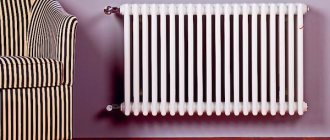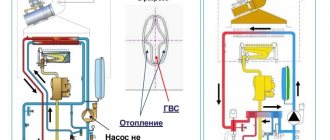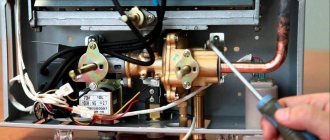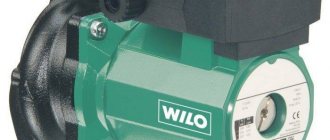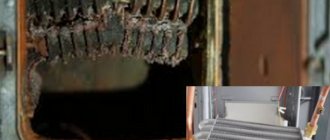[contents]
There are several reasons why water boils in a heating boiler. For example, boiling is often a consequence of the fact that the liquid is heated in the boiler faster than the thermal energy is transferred to the heating main. This happens due to:
- incorrect installation of the system;
- the fact that there is no circulation (or its speed is low) - usually occurs in open-type systems with an expansion tank;
- too much power of the device compared to batteries;
- low amount of water in the main.
Low circulation rate
So, if the coolant circulates too slowly, the coolant will not fully transfer the resulting heat and, as a result, the water in the boiler will boil. This applies only to those systems in which there is natural circulation of liquid, and the angle of inclination or diameter of the pipes is chosen incorrectly.
Note! In systems with forced circulation, this happens only in cases where the pump power is too low or it has completely failed.
Technical characteristics and dimensions of STS20R
| Manufacturer country | Germany |
| Valve type | one-way |
| Opening temperature, °C | 97 (/- 2) |
| Temperature (max), °C | 107 |
| System pressure (max), bar | 10 |
| Capillary tube length, mm | 1300 |
| Sensor length, mm | 145 |
| Cold water connection thread | internal G¾ |
| Heat source connection thread (sensor thread) | external G½ |
| Housing material | brass |
H. 133mm L. 1300mm G. 1/2″ h. 145mm
Not enough coolant
If there is too little water in the system or air pockets have formed, this may also be the reason why the water boils in the heating boiler. If there is an expansion tank, then you simply need to add water. In other cases, it is enough to bleed the air (if there is no automatic valve, of course).
To increase the circulation intensity, the heating system should be re-equipped, and it is better, if possible, to install a circulation pump. In this case, even if the pipes are not tilted correctly, the water will circulate properly.
Answer
Water in a heating boiler may boil because the rate of heating in the boiler exceeds the rate of heat transfer in the home heating system. This can happen for several reasons:
- insufficient coolant circulation rate or its absence;
- insufficient amount of coolant (water) in the system - most often happens in open systems with an expansion tank;
- excess power of the heating boiler compared to the total power (heat transfer) of the heating radiators of the house, taking into account losses - in the absence of a system for regulating the draft (power) of the boiler;
- improper installation of the heating system.
Now let's look at these reasons in more detail.
If the coolant circulation rate is insufficient, the heated water does not have time to release the heat received in the boiler into the system and can heat up in the boiler to the boiling point. This can happen in heating systems with natural coolant circulation if the correct pipe installation slopes are not observed or, less often, if their diameter is insufficient. With a forced circulation system, this can happen if the circulation pump is not selected correctly, is faulty, does not work, or there is no electric current supplied to it.
Also, the water in the boiler can boil if for some reason there is not enough water (coolant) in the system and air gets into it. If you have a heating system with natural circulation and a conventional expansion tank, this sometimes happens and in this case you just need to add water. Depending on the design of the heating system, sometimes it is necessary to bleed air from the system or some part of it (in the absence of an automatic valve).
To increase the circulation of water in the heating system, it is necessary to remodel the heating system or, best of all, install a circulation pump. Even with not entirely correct pipe slopes or in their absence, the circulation pump will provide the necessary circulation.
Water in the heating system can also boil if the installed boiler’s power is much higher than the heat transfer power of the entire system, especially if there is no or malfunction of the automatic regulation (draft) air supply system. In this case, it is necessary to install a semi- or automatic draft control system, replace the boiler (if it is homemade without a draft control system) or increase the number or power of radiators. Also, as an option, you can install an indirect water heater (boiler) in the system, which will take part of the heat from the system to heat water and serve as a kind of heat accumulator.
High boiler power
If the power of the device is higher than the heat transfer of the main line, this can also lead to boiling of water. Especially if the air supply control system is broken or missing altogether. There are several options to solve the problem:
- install an automatic adjustment system;
- install a similar one, but semi-automatic;
- change the boiler (if you made it yourself);
- increase the number of batteries;
- increase their power.
Note! In addition, you can embed an indirect heating boiler into the main line - this device will “absorb” some of the energy from the water heating system and serve as a kind of heat accumulator.
Chimney requirements
To determine what characteristics the manufacturer himself presents, you need to read the instructions, because specific data is given there, what is the minimum cross-section of the pipe needed, height, temperature conditions - these factors in a particular case are fundamental and you need to focus on them. As a rule, the instructions contain the manufacturer writes which chimney is better for a solid fuel boiler and what technical parameters need to be taken into account. The above listed characteristics, such as the height and length of the chimney, will allow you to choose a reliable and, most importantly, functional channel from the point of view of this particular model.
Consider the diameter of the chimney for a solid fuel channel, because not every channel will be able to remove the formed amount of gas in a certain time, and accumulated fumes and gases can enter the room through unsealed joints and cracks.
Circulation problem
If you have a circulation pump, but the system is unstable, then the problem may lie there. To check the functionality, place your hand on the battery - if you feel a slight vibration, it means the pump is working normally, if not, follow these steps.
- Check and clean electrical contacts.
- Check the pump parts for wear and lime deposits (if using regular tap water).
- Finally, you can turn off the pump, unscrew the plug and turn the shaft with extreme caution. This should help for a while. Citric acid can be used to remove deposits.
Principle of operation
Schematically, the OS heating circuit can be represented as a long vertical ring. One side of the ring
- with hot water (supply riser from the boiler to the boiler),
the other side
- with cold water (riser with return from the radiators). The density of a hot coolant is less than that of a cold fluid - water expands when heated.
Consequently, the weight of water and the pressure of the water column in the cold part of the circuit will be higher than the weight of water and the pressure of the column in the hot leg.
According to the law of communicating vessels, the liquid will tend to balance the pressures - to move from the cold branch to the hot one.
Since the circuit is such a closed ring, circulation or gravity flow of the coolant occurs.
- The supply riser is maximally insulated along its entire height.
- The boiler is located as far down as possible from the last radiator.
- The circuit has a container for releasing the excess volume of heated coolant
- an expansion tank (to ensure a reduced density and low pressure of the water column in the heated branch).
With natural circulation
During natural circulation, the coolant moves under the influence of the circulation pressure Pн
(in mm water column):
Pn=H x (cold - phot).
- H
- height difference between the boiler and the last radiator, m; - phol
- density of water in the cold return riser,
kg/m³
; - phot
- density of water in the hot supply riser,
kg/m³
.
During circulation along the circuit, the coolant spends part of the pressure to overcome the hydraulic resistance of pipes, radiators, and shut-off valves. Therefore, when designing an operating system, materials with low hydraulic resistance
so that their total does not exceed the design pressure
Pn
(do not block the system).
Important! The OS coolant contains air, which is mixed in the expansion tank. To remove air, pipes are made with a slope of at least 3-5 mm per p.
m. pipes.
With circulation from a pump
To increase the natural pressure, a circulation pump is included in the OS circuit.
There are two pump insertion points
to existing OS:
- On the return pipe in front of the boiler.
The expansion tank is reconnected to the return pipe in front of the pump (in the suction zone). - On the upper supply pipe
immediately after the expansion tank connection point.
Reference!
The pump insertion point is equipped
with a bypass
with a reed check valve.
Single-pipe
A single-pipe system with natural circulation is made only with upper coolant distribution.
All radiators in the riser of a single-pipe OS are connected in series - the output of one battery is connected to the input of another.
- Small number of pipes.
- Easy to install.
- The system is unbalanced
- the top batteries are hot, the bottom batteries are cold. To equalize the temperature regime, lower radiators are installed with a large number of sections. - Impossibility of thermoregulation
due to high resistance of control valves.
Most common situations
The most common source of the problem is an air lock in one of the nodes. It is necessary to carefully examine the entire system, focusing on the circulation of hot water. If a warm liquid comes from a pipeline instead of a hot one, it means that this is where an accumulation of air has formed. It is necessary to bleed excess air from the system using bleed valves. If this problem was not detected during the inspection, most likely the cause of the boiling lies directly in the functionality of the boiler.
Overheating of a boiler based on a gravity heating system can be caused by insufficient coolant circulation in the circuit. In this situation, you should place the expansion tank at the highest point in the house, in which case an additional load will be placed on the boiler and the required heated resource will be directed to it.
Experts recognize the most practical method of solving the problem as installing a circulation pump and equipping the heating system with a mixture circuit. Both types of devices allow you to reduce the load on the functionality of the heating device; cooled water will be added to the network. The boiler will receive return flow, which will provide natural cooling.
Thermal relief valve Regulus BVTS 14474
The one-way valve Regulus BVTS 14474 is used in heating systems to protect boiler equipment from overheating. The safety valve is a non-volatile device. When the temperature reaches 55 °C, the safety valve automatically supplies cold water for cooling. Hot water is released through the corresponding valve outlet.
The thermal relief valve Regulus BVTS 14474 has compact dimensions and is made of high-quality and reliable materials that are harmless for contact with drinking water: brass body, copper sensor and capillary tube, stainless steel spring. The corrugated steel shell serves as protection for the capillary and also prevents twisting during installation.
For proper operation of the safety valve, the capillary sensor must be installed at the top point of the boiler equipment or on the outlet pipeline at the closest possible distance to the boiler, where the water temperature during overheating is the highest.
The Regulus BVTS 14477 thermal relief valve is also used to protect against fuel fire in the supply mechanism of pellet heating boilers, preventing a fire in the fuel bunker. In this case, a capillary temperature sensor is installed directly into the pellet transport device and after opening the valve, water will flood the conveyor and extinguish the burning fuel.
Why does a gas boiler boil?
During normal operation of the equipment, the coolant in the circuit warms up to the set temperature. After which it is distributed naturally or forcibly through the heating system through the pump. This is how the radiators in the room warm up. The liquid then moves along the return circuit and returns to the boiler.
In case of overheating of the coolant, thermal sensors are activated. As a result, the operation of the device is blocked. What to do if the boiler boils? To restore heating, it is necessary to find the cause of the breakdown. Sometimes the self-diagnosis system displays an error code:
But if this does not happen, the problem can be identified by external signs.
What causes overheating:
- Clogged filters;
- Air accumulation;
- The heat exchanger is clogged with scale;
- Problems with the circulation pump;
- Failure to comply with regulations for the premises where the equipment is installed.
How does the heating system work?
The functioning of the heating system in a private house is ensured by the fact that water/antifreeze is heated in the boiler to the set temperature. Through heating pipes, the liquid is directed to the radiators, from which the room is heated. After this, the already cooled liquid comes back, where it is again automatically heated.
Heating system diagram
Expansion tank device
Structurally, this container is very simple. The material used is translucent plastic. Also, a sensor can be additionally built into the tank, which signals the driver about a critical decrease in the coolant level.
The top of the tank is closed with a lid in which a valve is installed to regulate the pressure. If the pressure in the system increases, then the valve operates.
Also on the wall of the tank there is a level indicator in the form of o and “maximum”, allowing you to control the liquid level
It is important to understand that on a cold engine the level should not fall below the minimum. It is also not allowed to exceed the maximum level
As for the tank cap with the valve, it seals the container hermetically on a cold internal combustion engine. However, when the engine reaches operating temperature and the coolant heats up, the pressure in the cooling system and in the tank naturally increases.
If the pressure rise reaches an average of 120 kPa, the valve opens. When the pressure drops to an average of about 83.4 kPa, the valve closes. This operation of the valve is necessary in order to avoid rupture of pipes, damage to the radiator, etc.
At the same time, after the engine cools down, the pressure in the system begins to drop, the volume of coolant decreases and a vacuum is created. When the pressure drops, on average, below 3 kPa, the inlet valve of the expansion tank opens to take in air. As a result, the pressure difference is leveled, and the missing volume of liquid is compensated from the tank.
Expansion tank
Located in the attic. Since the attic is usually an unheated room, the tank must be insulated, otherwise the water in it may freeze in winter. The tank compensates for temperature fluctuations in the water level. In addition, sometimes water in the system can boil (this happens if you start heating the boiler too quickly), and the bubbles significantly increase the volume. This is what the excess volume in the expansion tank is for.
It is advisable to provide for the possibility of draining excess water from the tank when it overflows. To do this, water can be discharged either into the sewer or simply onto the street.
It should be borne in mind that water from an open system evaporates. Therefore, it is necessary to replenish the system with water. This can be done manually, periodically climbing into the attic and adding water, or you can make an expansion tank similar to a toilet - with automatic topping up of water.
But they rarely do this. Usually they just use a container.
It is better to close the top of the tank with a lid so that less water evaporates.
